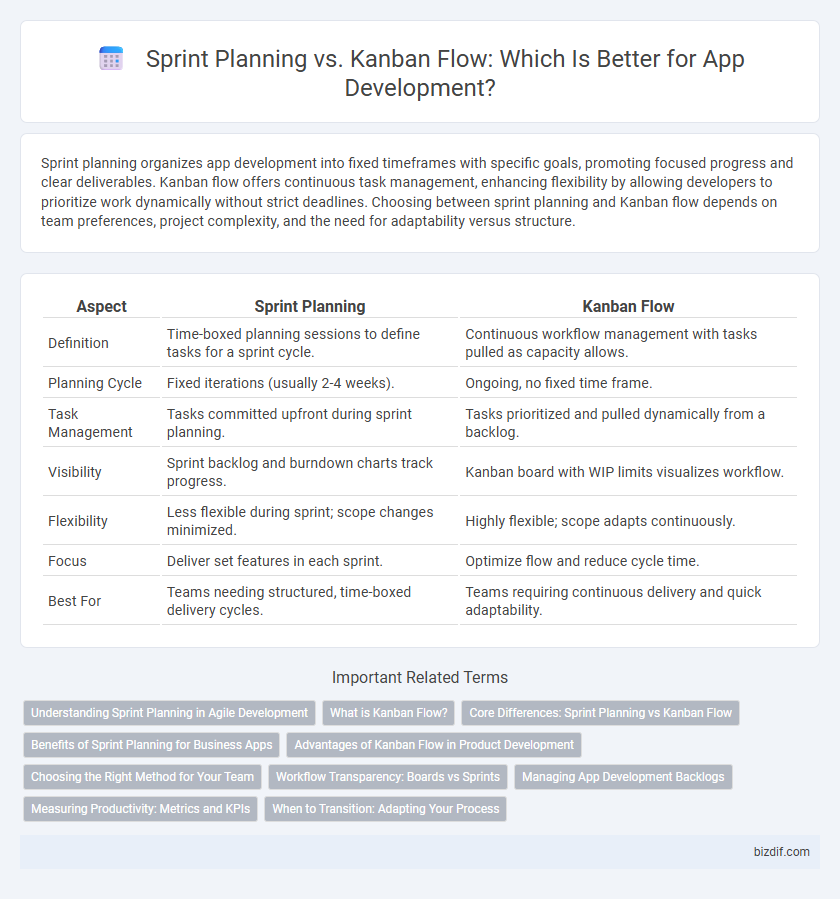Sprint planning organizes app development into fixed timeframes with specific goals, promoting focused progress and clear deliverables. Kanban flow offers continuous task management, enhancing flexibility by allowing developers to prioritize work dynamically without strict deadlines. Choosing between sprint planning and Kanban flow depends on team preferences, project complexity, and the need for adaptability versus structure.
Table of Comparison
| Aspect | Sprint Planning | Kanban Flow |
|---|---|---|
| Definition | Time-boxed planning sessions to define tasks for a sprint cycle. | Continuous workflow management with tasks pulled as capacity allows. |
| Planning Cycle | Fixed iterations (usually 2-4 weeks). | Ongoing, no fixed time frame. |
| Task Management | Tasks committed upfront during sprint planning. | Tasks prioritized and pulled dynamically from a backlog. |
| Visibility | Sprint backlog and burndown charts track progress. | Kanban board with WIP limits visualizes workflow. |
| Flexibility | Less flexible during sprint; scope changes minimized. | Highly flexible; scope adapts continuously. |
| Focus | Deliver set features in each sprint. | Optimize flow and reduce cycle time. |
| Best For | Teams needing structured, time-boxed delivery cycles. | Teams requiring continuous delivery and quick adaptability. |
Understanding Sprint Planning in Agile Development
Sprint planning in Agile development revolves around defining clear goals and selecting backlog items to deliver a functional product increment within a fixed timebox, typically two to four weeks. This process enhances team alignment by prioritizing tasks based on business value and team capacity, ensuring focused and measurable progress. Unlike Kanban flow, which emphasizes continuous delivery and work-in-progress limits, sprint planning provides a structured cadence for iterative development and regular reflection.
What is Kanban Flow?
Kanban Flow is a visual project management tool designed to optimize workflow efficiency by using a Kanban board that visualizes tasks across different stages. It enables continuous delivery by allowing teams to pull work items as capacity permits, reducing bottlenecks and improving cycle time. The tool integrates time tracking and task prioritization features to enhance productivity and maintain steady progress without fixed sprint durations typical in Sprint planning.
Core Differences: Sprint Planning vs Kanban Flow
Sprint planning centers on defining fixed-length iterations with a clear set of deliverables, enabling teams to commit to specific goals within a time-boxed period. Kanban flow emphasizes continuous delivery through visualizing work progress on a board, limiting work in progress (WIP), and allowing for flexible task prioritization. While sprint planning promotes structured cycles and predictable delivery, Kanban provides adaptability and ongoing workflow optimization in app development.
Benefits of Sprint Planning for Business Apps
Sprint planning creates structured timelines and clear deliverables, enhancing predictability for business app development. It enables prioritization of critical features, improving resource allocation and ensuring alignment with key business objectives. This method fosters focused collaboration among teams, accelerating innovation and reducing time-to-market for high-impact app functionalities.
Advantages of Kanban Flow in Product Development
Kanban flow enhances product development by promoting continuous delivery and limiting work in progress, which reduces bottlenecks and improves team efficiency. Visualizing tasks on a Kanban board allows real-time tracking of progress and quick identification of blockers, leading to faster response times. This method offers flexibility in managing priorities, enabling teams to adapt swiftly to changing requirements without disrupting the overall workflow.
Choosing the Right Method for Your Team
Sprint planning offers structured time-boxed iterations ideal for teams seeking clear deadlines and defined deliverables, enhancing focus and predictability in app development. Kanban flow emphasizes continuous delivery and visual workflow management, supporting flexibility and rapid response to changing priorities. Selecting the right method depends on your team's project complexity, delivery cadence preferences, and adaptability to evolving requirements.
Workflow Transparency: Boards vs Sprints
Sprint planning organizes work into fixed-time iterations, offering clear goals within each sprint, enabling teams to focus on a set amount of tasks. Kanban flow emphasizes continuous delivery with a visual board that tracks task progress in real-time, promoting ongoing workflow transparency. Boards provide flexibility with dynamic task prioritization, while sprints enforce structured timelines for better predictability in app development projects.
Managing App Development Backlogs
Sprint planning structures app development backlogs by defining clear, time-boxed goals and prioritizing user stories for efficient iteration cycles. Kanban flow optimizes backlog management through continuous task visualization and flexible workflow adjustments, enhancing responsiveness to changing requirements. Choosing between sprint planning and Kanban depends on team dynamics, project complexity, and the need for either predictable delivery or adaptive iteration.
Measuring Productivity: Metrics and KPIs
Sprint planning relies on time-boxed cycles, making velocity and sprint burndown charts critical metrics for measuring productivity, while Kanban flow uses continuous delivery with cycle time and cumulative flow diagrams as key KPIs. Velocity tracks story points completed per sprint, offering insights into team capacity, whereas cycle time measures the duration from task start to completion, highlighting workflow efficiency. Monitoring work-in-progress (WIP) limits in Kanban also helps identify bottlenecks and maintain a steady throughput.
When to Transition: Adapting Your Process
Sprint planning suits projects with fixed deadlines and defined deliverables, enabling teams to focus on clear goals within set timeboxes. Kanban flow excels in environments requiring continuous delivery and flexibility, adapting to changing priorities without strict iteration boundaries. Transitioning between these methodologies depends on project predictability, team capacity, and the need for adaptability in workflow management.
Sprint planning vs Kanban flow Infographic

 bizdif.com
bizdif.com